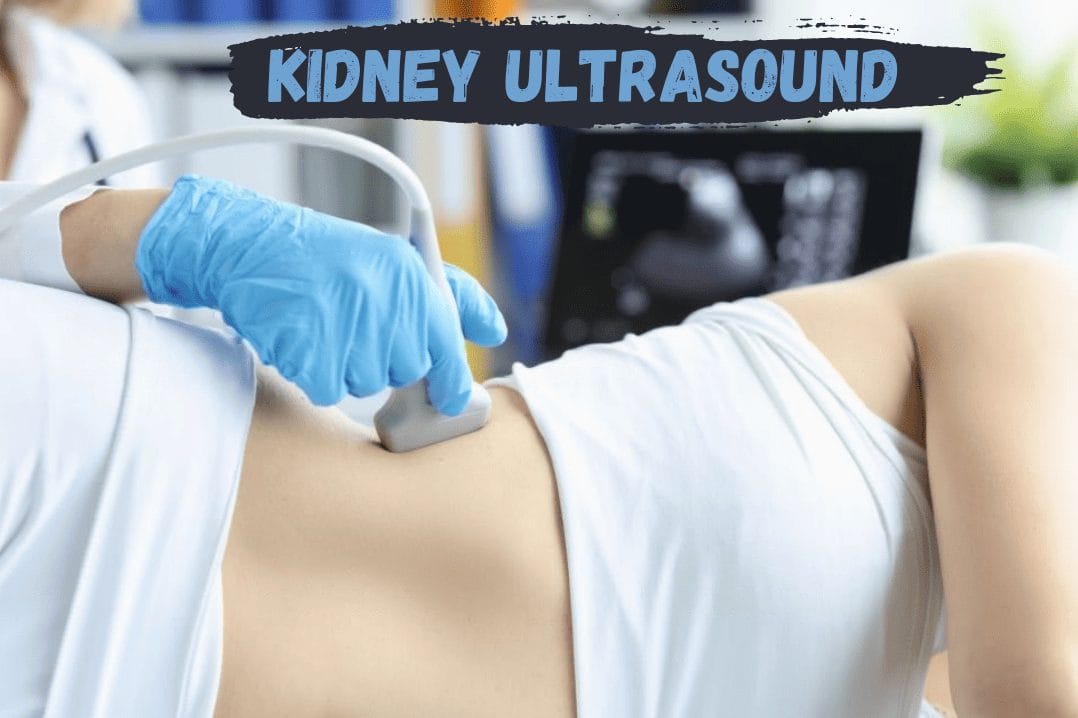A kidney ultrasound is a procedure that uses sound waves to create an image of the kidneys. It allows doctors to check the size, shape, and position of the kidneys and any fluid-filled cysts or tumors that may be present.
What is a Kidney Ultrasound?
Kidney ultrasound, also called renal ultrasound, uses high-frequency sound waves to create detailed images of the kidneys. It provides information about the kidneys’ size, shape, and structure. The procedure is non-invasive and safe for all ages, including pregnant women, as it does not involve radiation. Healthcare professionals use kidney ultrasound to detect kidney conditions like stones, cysts, tumors, and infections. A kidney ultrasound monitors kidney health, assesses transplant success, and guides medical interventions. It is effective, safe, and cost-efficient, making it an essential tool in nephrology.
Kidney ultrasound procedure

The kidney ultrasound procedure is a non-invasive and painless examination. Here’s what you can expect:
Preparation
No special preparation is required before the procedure. However, your healthcare provider may advise you to drink plenty of water for a full bladder, which helps obtain clearer kidney images.
Positioning
The healthcare provider will position you on a bed. You will typically lie on your back. The areas under observation, abdomen or back, will be exposed.
Gel Application:
They will apply a clear, water-based gel to your skin over the marked area, enhancing sound wave transmission and improving image quality.
Transducer Movement:
Using a handheld transducer, the sonographer will move it gently over your skin in the area of interest. The transducer emits high-frequency sound waves and captures the echoes as they bounce back from the kidneys, obtaining comprehensive images from different angles.
Image Evaluation
The captured images are displayed on a monitor in real time. A sonographer or radiologist will interpret the images, evaluating the size, shape, and structure of the kidneys and making note of any abnormalities or areas of concern.
Completion
Once the necessary images are obtained, the sonographer will wipe off the gel from your skin. There is no recovery time, and you can resume your normal activities immediately.
Duration of the Procedure
The procedure takes 15 to 30 minutes, depending on complexity. It is a comfortable procedure without injections, radiation, or known risks. You may feel slight pressure from the transducer but no discomfort. The images are reviewed by a radiologist, who communicates the results to your healthcare provider.
Uses of Kidney Ultrasound

· Kidney Stone Detection
It identifies kidney stones, allowing timely treatment.
· Kidney Disease Diagnosis
It detects polycystic kidney disease, kidney cysts, tumours, and hydronephrosis.
· Urinary Tract Infections (UTIs)
It assesses the kidneys and urinary tract for recurrent UTIs.
· Monitoring Kidney Transplants
It monitors transplanted kidney function and identifies complications.
Benefits of Kidney Ultrasound
· Non-Invasive and Painless
It is a safe, painless procedure without radiation exposure.
· Real-Time Imaging
It provides immediate visualization and assessment of kidney function.
· Cost-Effective
It is affordable and serves as an initial screening tool.
· Guided Procedures
It assists in kidney biopsies and fluid drainage, ensuring accuracy.
Conclusion
Kidney ultrasound revolutionizes kidney health evaluation. It detects abnormalities early, leading to timely treatment. Consult a healthcare provider if you have kidney concerns. Early detection is crucial in managing kidney diseases effectively.
FAQs
What should I expect during a kidney ultrasound?
During a kidney ultrasound, the sonographer will ask you to lie on a bed. They will apply a gel to your abdomen or back and gently move a transducer over the area to capture images of your kidneys. The procedure is painless and typically takes around 30 minutes.
Is kidney ultrasound safe for pregnant women?
A kidney ultrasound is safe for pregnant women as it doesn’t involve radiation and uses sound waves for imaging.
Can a kidney ultrasound detect all types of kidney problems?
While kidney ultrasound is a valuable diagnostic tool, it may not detect all kidney problems. It is particularly useful for visualizing kidney stones, cysts, and tumors and assessing the overall structure of the kidneys. Additional tests, such as CT scans or MRIs, may be required for more detailed evaluations.
The Editorial Team at Healthcare Business Today is made up of skilled healthcare writers and experts, led by our managing editor, Daniel Casciato, who has over 25 years of experience in healthcare writing. Since 1998, we have produced compelling and informative content for numerous publications, establishing ourselves as a trusted resource for health and wellness information. We offer readers access to fresh health, medicine, science, and technology developments and the latest in patient news, emphasizing how these developments affect our lives.








